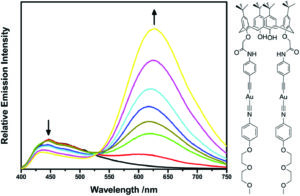Prof. Vivian W. W. Yam and Dalton Transactions
This year, we are celebrating the 50th volume of Dalton Transactions by taking a look at some of our authors who have published over 50 articles in the journal. This week we learn what Dalton Transactions means to Professor Vivian W. W. Yam.
Our author at a glance:
Prof. Vivian Yam is based at the University of Hong Kong, and her research focuses on coordination and organometallic chemistry, supramolecular chemistry, materials chemistry and photochemistry. Vivian chooses to publish in Dalton Transactions because “it is an international reputable society journal dedicated to inorganic and coordination chemistry research.”
Please can you summarise your most recent research published in Dalton Transactions?
Our most recent research works published in Dalton Transactions involve the design and spectroscopic studies of functional metal complexes for luminescence, donor-acceptor charge transfer, supramolecular assembly and chemosensing.
How do you intend to expand upon your research in the future?
We would like to expand our studies through an understanding of weak intermolecular forces and the interplay of various factors that influence the controlled manipulation and assembly of molecular metal complexes and their excited states for functional materials research.
What would you say are the biggest barriers which need to be overcome to expand your research?
The biggest barriers are to be able to control and manipulate the molecular configurations and supramolecular assemblies of our systems in order to perturb the electronic communication and coupling to control the excited states and their charge transfer behaviour. The understanding of how microscopic properties can influence the macroscopic properties is also crucial to the design of molecular materials with desired functional properties. The computational power and its ability to provide accurate theoretical description and insights into the electronic structures of large molecules, clusters and assemblies are also important.
You’ve published over 50 articles in Dalton Transactions, which of these works do you find to be most interesting/significant for our broad inorganic audience?
One important piece of work is the design and discovery of luminescent organogold(III) diimine complexes. Gold(III) complexes have long been known to be non-emissive. This work demonstrates for the first time the use of strong σ-donor ligands like alkyls and aryls in generating luminescent gold(III) complexes with room-temperature phosphorescence. This has laid the foundation for our subsequent works on luminescent gold(III) complexes for OLED applications. Another work involves the systematic study of luminescent trinuclear two- and three-coordinate gold(I) complexes with Au(I)…Au(I) interactions. Other works on luminescent metal alkynyls, chalcogenides and chalcogenolates of gold, silver, copper, platinum and palladium and others are also key to the development of luminescent metal complexes and their excited states.
Outside of your own research, please suggest a Dalton Transactions article which you think has made a significant contribution to its field?
There are so many seminal works in Dalton Transactions and many of them have made a significant impact to the field. It is difficult to select just one.
What advice do you have for young researchers new to your field?
Chemistry is a central science. Transition metal chemistry is fascinating given the diverse array of metals and metal chemistry that one can explore. It is important to build a strong foundation not only in chemistry and its sub-disciplines, but also in other disciplines of science. Read widely to develop the common language to interact with scientists from other disciplines. Be creative, adventurous and forward-looking. There is so much to be learned and to be inspired by. It is a life-long self-learning process.
What does Dalton Transactions mean to you?
Quality, rigour, professional, international and friendly.
Why do you choose to publish in Dalton Transactions?
It is an international reputable society journal dedicated to inorganic and coordination chemistry research. The manuscripts receive prompt, fair and quality handling.
What is your experience of publishing with Dalton Transactions?
I have good experience of publishing with Dalton Transactions. The editors and editorial team are professional, helpful and caring.
You can check out Vivian’s most recent Dalton Transactions article on functional metal complexes for luminescence below.
 Synthesis and cation-binding studies of gold(I) complexes bearing oligoether isocyanide ligands with ester and amide as linkers
Synthesis and cation-binding studies of gold(I) complexes bearing oligoether isocyanide ligands with ester and amide as linkers
Franky Ka-Wah Hau and Vivian Wing-Wah Yam*
Dalton Trans., 2016, 45, 300-306
Check out the full collection of recent research published in Dalton Transactions by all of our featured Golden Authors in our Celebrating our Golden Authors collection.











